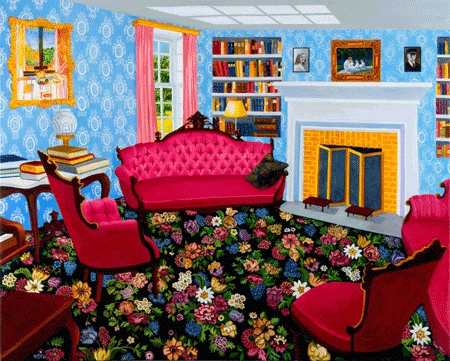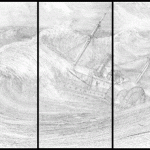Meet a NYFA Artist: Roxa Smith
Family Tree, 2010, oil on canvas, 36 x 45 inches
NYFA talks to Roxa Smith (2012 Painting Fellow & 2011 Artist as an Entrepreneur Boot Camp Participant) about her biggest obstacles as an artist, her process, and her workspace. She also shares advice for emerging artists looking to further their careers.
NYFA: How did you start creating art? What influenced you?
RS: I grew up in a very creative household. My mother was a commercial artist by training and was an amateur sculptor/designer and architect. She encouraged my siblings and me to draw and paint in home projects and games. I was born and raised in Venezuela. When we were young, my parents took us traveling all over Venezuela and exposed us to the rich art of colonial towns and churches as well as to the indigenous and folk art of the Venezuelan people. I am sure that the color and the naïve quality of my work stems from the influence of these early years.
I finished high school and college in the US. There, I took some formal art classes, but it was really the art history classes I took at Bowdoin College that made me passionate about art. When I graduated from college, I knew I wanted to work in the art field, but I wasn’t sure how. After spending an unproductive year in New York City pursuing different art venues, I went to Santa Cruz, California and joined a group of ‘plein-air’ painters lead by Lundy Siegriest and Terry St. John, one of the original Bay Area ’plein air’ painters of the 1970’s. Joining this group renewed my love for painting. I began to paint daily outdoors and in the studio. I developed close friendships with artists and eventually, I began attending art classes at the University of Santa Cruz (UCSC). This was in the late 1980’s. UCSC was a great campus for painters and printmakers. I met a group of artists who to this day are still pursuing art as passionately as ever and some of them are quite successful. The people I met at USC, both teachers and colleagues, inspired me, molded my work ethic and gave me the strength to pursue the life of an artist.
NYFA: What are your biggest influences and sources of inspiration?
RS: My professor, Hardy Hanson, at UCSC had a profound effect on my work. He inculcated many of the work ethics I have as a painter today. For example, he told us to be patient with our process, to not take short cuts to finish a piece, to not look for easy answers and to constantly engage with our work and challenge it. He taught me to stay with a piece even if I didn’t like it and learn to push the piece and experiment with it. I learned that sometimes this would lead to a strong and realized piece and sometimes I would ruin it, but it was always instructive.
The years I spent in Santa Cruz and in particular at the University of Santa Cruz art department defined my career as a visual artist. After this time, I knew I couldn’t do anything else as meaningful as painting. In 1989, I went to the Matisse in Niece show at the National Gallery of Art in Washington D.C. I sketched every single one of the paintings in the show. It was then that my love for interiors really began. In the subsequent years, I experimented in a lot of styles and subject matters, but painting interiors always remained a backbone of my work.
Besides Henri Matisse, there are numerous painters that inspire me, but Pierre Bonnard is at the top of the list. I am mesmerized by the way he translated his intimate and daily life experiences into canvases full of color and light. Henri Rousseau, Paul Klee, Giorgio Morandi, Frida Kahlo, Hector Poleo and Paul Gauguin, are some of the artists I have studied at length. I also really like the art of self-taught artists, folk and outsider art and the freshness of children’s work. Finally, Persian and Indian miniature painting is a source of inspiration for its meticulousness, its details and for its story telling quality. I also find inspiration in any kind of patterns: in rugs, wallpapers, tiles, wood grains and patterns caused by light and shadow. In fact, I find that any part of my environment can be a source of inspiration. It all depends on how I take note of my environment and choose to translate it into my paintings.
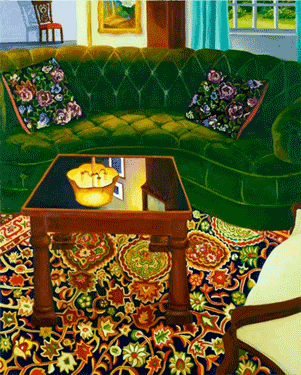
Conversations, 2011, oil on canvas, 30 x 24 inches
NYFA: What is one of the biggest obstacles you as an artist have to overcome? Is it present in your work?
RS: Lack of patience in my work and in the process of creating is one of the biggest obstacles I have to overcome. My work process is very labor intensive and time consuming. I am constantly battling with the desire to work faster and accelerate my process. However, I know that the work I am doing takes time and if I take short cuts or don’t work as meticulously, the work will suffer. Therefore, I can’t compare myself to artists who can produce complete bodies of work in the time it takes me to do 2 or 3 paintings. The more I can simply focus on my work and give myself time and concentration, the happier I am and the stronger my work becomes. My second obstacle is to not compare my art achievements to those of art colleagues and contemporaries. Again, the more I can stay focused on my process, the happier and ultimately more successful I will be.
NYFA: If you weren’t a professional artist, what would you be doing?
RS: I’d probably work in a field that involved design, color and pattern and people’s surrounding. I always thought I would like to be an architect, an interior designer or a landscape artist.
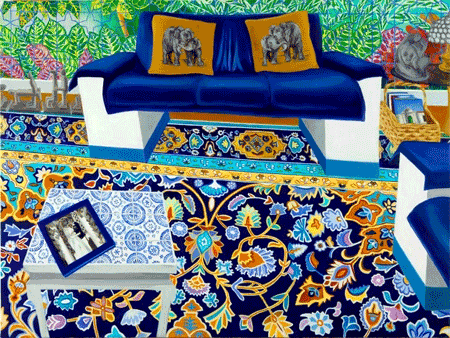
Continuity,2011, oil on canvas, 30 x 40 inches
NYFA: How do you describe your process as an artist?
RS: I am constantly thinking and looking for subject matter or for elements that could be a part of my paintings. I spend a lot of time searching for images. I am always taking pictures of spaces and/or of details for research. For example, I have folders for rugs, wood patterns, kitchen objects, wallpaper, houseplants, and flower plants and so on. I also use the NY Public Library Picture collection to look for images and inspiration. Recently, I have been taping a lot of the photos I take on my studio walls and using them as well as images from other sources to make sketches of potential paintings.
I select personal and emotionally charged subjects to capture the fleeting memory of a place and time. Instead of faithfully documenting a space, I want to portray its essence; to illuminate the spirit of the interior by focusing on the architectural elements, the light, and the complex patterns of the space.
I usually make sketches of a potential painting and once I have decided on a drawing, I will sketch it on the canvas and loosely place down color. Since my paintings are labor intensive and time consuming, I need to be sure that I want to commit to the subject matter. However, my paintings have a life of their own and no matter how much planning I do, inevitably I have to allow myself to respond to what is actually happening on the canvas, to have a dialogue with the piece, to add, delete or completely change parts of the piece until it “gels.” It is not unusual for me to go into a painting that I am not totally satisfied with even if I haven’t worked on it for over a year. Finally, I am totally consumed with detail, and place equal importance on the detail of the foreground as I do on the background. I want the viewer to be drawn in to my paintings and be equally captured by color, pattern and detail. A painting can easily take me months to complete.
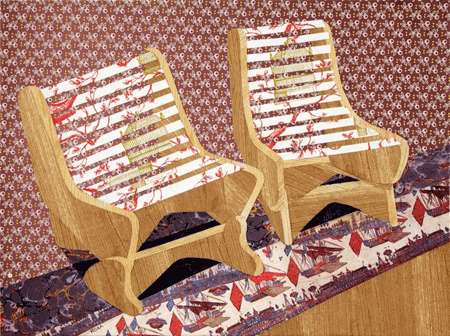
Intimacy,2012, collage on board, 12 x 16 inches
NYFA: Describe your ideal day.
RS: I wake up by 7:00 am, go to the gym or do yoga for an hour/hour and a half and have a good breakfast. I get to the studio between 9:00 and 10:00am. I put in 8 or 9 hours at the studio. Go back home. Either make a nice dinner at home or get together with friends to eat dinner, go to a movie or a cultural event. Basically, spending a full day at the studio is my ideal day. I have a day job, so ideal days like these only happen on the weekend or when I am on vacation or in a residency.
NYFA: What is your work space like?
RS: My studio is in Greenpoint, Brooklyn. It is a room on the 4th floor of a railroad apartment. I have my own entrance, separate from the other side of the apartment, so it is my private space. It is a long and narrow room (11 feet by 23 feet) which has a partition that divides it in two. When you walk in, there is a smallish alcove big enough to display a large a painting on either side of the wall. Past the alcove is the main part of my studio. On the right is the wall where I work. I usually have 3 paintings on that wall which I rotate around. Across from that wall is a fake fire place. To the left and right of the fireplace, there are two nooks. In the left nook, I have a rack that goes up to the ceiling for my smaller paintings and my drawing table and book shelf are in the right nook. There are 3 windows at the end of the room which face south. My studio is bathed with light. There are a lot of large canvases leaning against the wall in both the alcove and in the main studio. Because of the proportions of my studio, I find myself limited to working at maximum 36×45. This is a drawback. I also wish my work space were in a more commercial setting, like an artist building, but like many New Yorkers, we work wherever we can. I feel lucky though to have a private space that is bright, quiet and safe and where I can be alone and lose myself in my work.
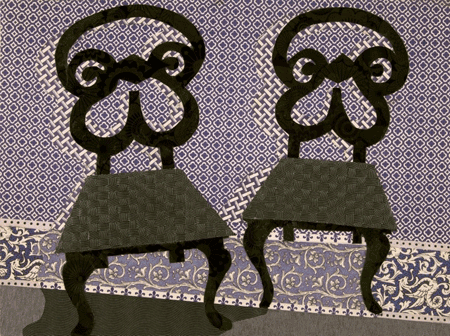
The couple, 2012, collage on board, 12 x 16 inches
NYFA: What advice would you give to a young or emerging artist?
RS: Be disciplined. Create a schedule for yourself and stick to it. After you finish school, life tends to take over and you need to make a commitment to carve out time to do art and to market yourself. Don’t be discouraged with rejections. Keep applying to shows, galleries, grants and alternative venues. Go to shows and find inspiration outside your studio, but don’t compare yourself, your vision and your process with others. Have a community of artist friends with whom you can share and get feedback on your work. Be persistent. Be patient with the creative and marketing practice. To be a successful artist you need to spend equal amounts on the business side as you do on the creative side. Don’t be afraid to experiment, but when applying to shows or grants, use a consistent body of work. Don’t rush into marketing your work before you have a strong body of work.
NYFA: How has the Fellowship affected your work/ trajectory?
RS: The Fellowship has been a shot in the arm. It has given me a lot of validation and proved that consistent work and belief in oneself can and does pay off. Being part of the NYFA community has and will open doors for me. It is a huge honor to be a Fellow and it carries a lot of weight when applying for grants and residencies. NYFA has already offered me an opportunity to show my work at the firm Fahrenheit 212 and to sell my work through the online galleries Paddle8 and Artspace. The money I received from the Fellowship was, of course, welcomed. It helped defray costs of materials and helped me pay for a Photoshop course. I still have some left and plan to take a course in photography and in silk screen. I am grateful to NYFA for giving me so much support and for honoring me with a Fellowship in Painting this year.
For more information on Roxa, please visit her website.

